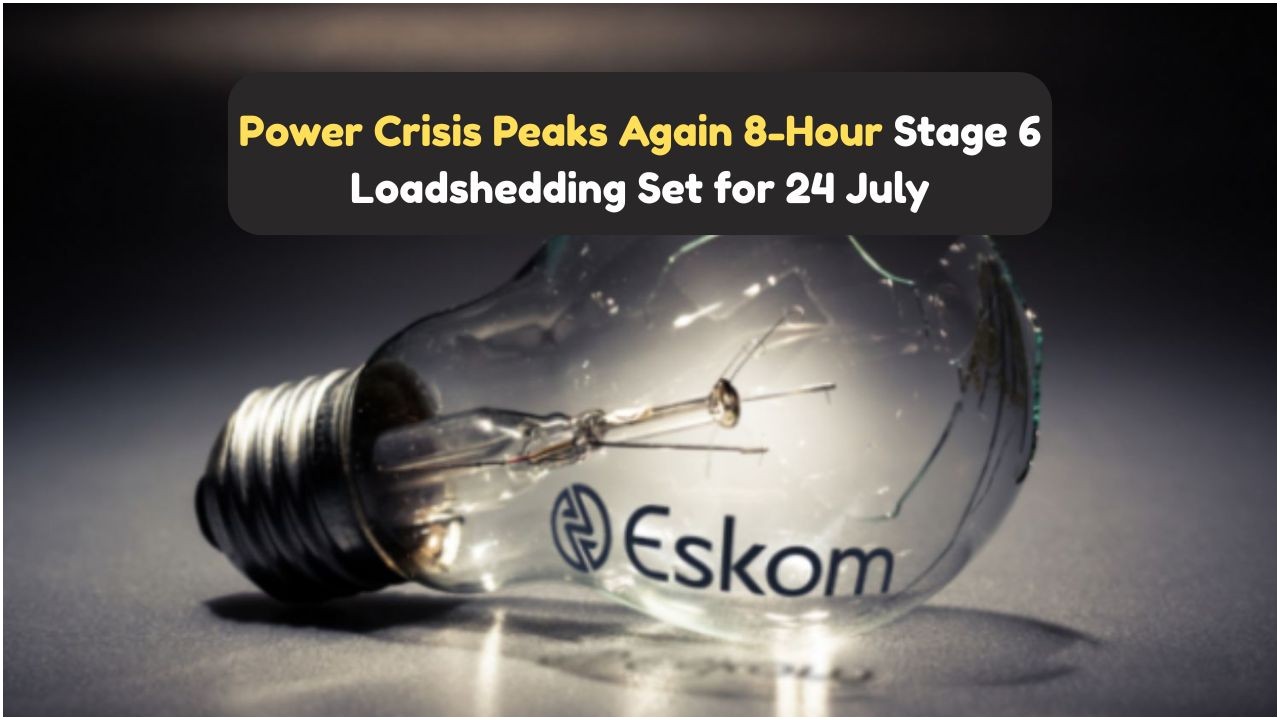Stage 6 Loadshedding Impact on 24 July: On 24 July, South Africa faced one of its most challenging energy crises as Stage 6 loadshedding was implemented across various regions. This severe level of power cuts not only disrupted daily life but also highlighted the ongoing struggles within the local energy sector. As residents and businesses scrambled to adapt, the hardest-hit areas experienced significant inconveniences, making it crucial to understand the full scope of this loadshedding event. Here, we delve into the regions most affected by these power outages, offering insights into how communities are coping and what this means for the future of power management in South Africa.
Understanding Stage 6 Loadshedding in South Africa
The concept of loadshedding is not new to South Africans, but understanding what Stage 6 entails is crucial for grasping its impact. At this stage, scheduled power cuts occur for up to six hours per day, affecting both residential and commercial areas. This level of loadshedding is typically implemented to prevent the entire grid from collapsing due to excessive demand or insufficient supply. During Stage 6, electricity is rationed more aggressively compared to lower stages, leading to more frequent and longer power outages.
- Increased frequency of power cuts
- Longer durations of outages
- Heightened impact on businesses
- Greater strain on households
- Emergency services affected
- Potential for economic slowdown
- Challenges in maintaining normalcy
Regions Hardest Hit by Loadshedding on 24 July
The 24 July loadshedding affected numerous regions across South Africa, with some areas experiencing more severe disruptions than others. Among the hardest-hit locations were major urban centers and industrial hubs where the demand for electricity is typically high. These areas faced extended outages, leading to disruptions in everyday activities and business operations. Residents were urged to use power sparingly and prepare for potential blackouts, while businesses had to find ways to minimize operational impacts.
| Region | Outage Duration | Impact on Residents | Impact on Businesses | Notes |
|---|---|---|---|---|
| Johannesburg | 6 hours | High | Critical | Traffic disruptions |
| Cape Town | 5 hours | Moderate | High | Public transport affected |
| Durban | 4 hours | Moderate | Moderate | Water supply issues |
| Pretoria | 5 hours | High | High | Communication interruptions |
| Port Elizabeth | 3 hours | Low | Moderate | Minimal disruptions |
| Bloemfontein | 4 hours | Moderate | Moderate | School closures |
| Polokwane | 3 hours | Low | Low | Normal operations |
| Nelspruit | 6 hours | High | Critical | Healthcare services affected |
Adapting to Frequent Loadshedding
As loadshedding becomes a regular occurrence, South Africans have had to find ways to adapt to this new reality. From investing in alternative power sources to adjusting daily routines, the resilience of communities is being tested. Many households are turning to solar panels and backup generators as a means to mitigate the impact of power cuts. Businesses, on the other hand, are investing in uninterrupted power supply (UPS) systems to ensure continuity of operations during outages.
 Thousands Stranded by August NSFAS Blockages: Discover the Viral R5,200 WhatsApp Hack to Solve It
Thousands Stranded by August NSFAS Blockages: Discover the Viral R5,200 WhatsApp Hack to Solve It
- Installation of solar panels
- Use of backup generators
- Shift in business hours
- Investment in UPS systems
- Community-based energy solutions
The Role of Government in Managing Power Supply
The South African government plays a pivotal role in managing the country’s power supply and addressing the ongoing energy crisis. Efforts to stabilize the grid include enhancing power generation capacity, improving infrastructure, and promoting energy efficiency. Despite these measures, challenges such as aging power plants and insufficient maintenance continue to hinder progress. To address these issues, the government is exploring partnerships with private entities to boost investment in the energy sector.
- Enhancing power generation capacity
- Improving infrastructure
- Promoting energy efficiency
- Addressing aging power plants
- Encouraging private sector investment
- Exploring renewable energy options
Community Efforts to Combat Loadshedding
Communities across South Africa are not just waiting for solutions from the government; they are taking proactive steps to combat the effects of loadshedding. From local initiatives to promote energy conservation to community projects focused on renewable energy, these efforts are crucial in building a more sustainable future. Collaborative efforts among residents, local businesses, and NGOs are proving to be effective in reducing reliance on the national grid.
- Local energy conservation initiatives
- Community renewable energy projects
- Partnerships with NGOs
- Educational programs on energy efficiency
- Collaborative efforts for sustainable solutions
- Development of local energy cooperatives
- Investment in community solar farms
Technological Innovations in Energy Management
Technological advancements are playing a significant role in addressing South Africa’s energy challenges. Innovations in smart grid technology, energy storage solutions, and renewable energy sources are paving the way for more efficient energy management. These technologies not only help in optimizing power distribution but also in reducing the overall demand on the national grid. For instance, smart meters and home energy management systems allow consumers to monitor and control their energy usage more effectively.
| Technology | Function | Benefits | Challenges |
|---|---|---|---|
| Smart Grid | Optimizes power distribution | Improves efficiency | Cost of implementation |
| Energy Storage | Stores excess energy | Reduces peak demand | Limited capacity |
| Renewable Energy | Generates sustainable power | Eco-friendly | Initial investment |
| Smart Meters | Monitors energy usage | Consumer control | Data privacy concerns |
| Home Energy Systems | Manages household power | Cost savings | Complex installation |
| Advanced Power Plants | Efficient energy production | Reduced emissions | Maintenance challenges |
| Grid Automation | Automates power supply | Reliability | Technical expertise required |
FAQs on Loadshedding in South Africa
What is Stage 6 loadshedding?
Stage 6 loadshedding involves scheduled power cuts for up to six hours a day.
How does loadshedding affect businesses?
Businesses experience operational disruptions, leading to potential financial losses.
What are some solutions to mitigate loadshedding?
Installing solar panels, using backup generators, and investing in UPS systems are common solutions.
How can I prepare for loadshedding?
Stay informed about schedules, invest in alternative power sources, and plan daily activities accordingly.
 Eastern Cape School Shuts Down Amid #JusticeForCwecwe Uproar: Parents Call for Immediate Action
Eastern Cape School Shuts Down Amid #JusticeForCwecwe Uproar: Parents Call for Immediate Action
What is the government doing to address loadshedding?
The government is working to enhance power generation capacity and promote energy efficiency.









